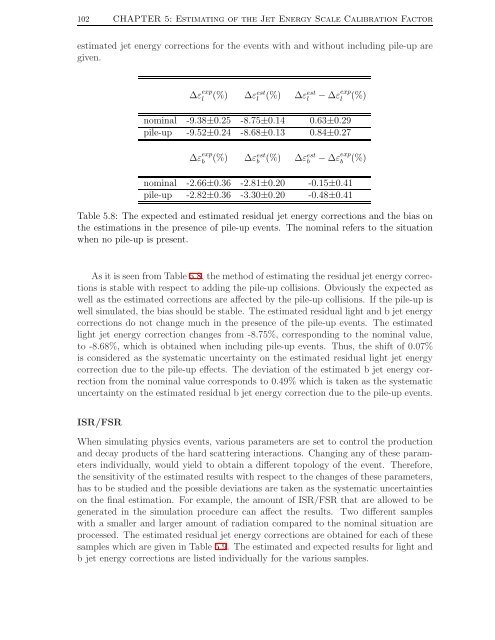Measurement of the Jet Energy Scale in the CMS experiment ... - IIHE
Measurement of the Jet Energy Scale in the CMS experiment ... - IIHE
Measurement of the Jet Energy Scale in the CMS experiment ... - IIHE
Create successful ePaper yourself
Turn your PDF publications into a flip-book with our unique Google optimized e-Paper software.
102 CHAPTER 5: Estimat<strong>in</strong>g <strong>of</strong> <strong>the</strong> <strong>Jet</strong> <strong>Energy</strong> <strong>Scale</strong> Calibration Factorestimated jet energy corrections for <strong>the</strong> events with and without <strong>in</strong>clud<strong>in</strong>g pile-up aregiven.∆ε expl(%) ∆ε estl (%) ∆ε estl − ∆ε expl(%)nom<strong>in</strong>al -9.38±0.25 -8.75±0.14 0.63±0.29pile-up -9.52±0.24 -8.68±0.13 0.84±0.27∆ε expb(%) ∆ε estb (%)∆ε estb− ∆ε expb(%)nom<strong>in</strong>al -2.66±0.36 -2.81±0.20 -0.15±0.41pile-up -2.82±0.36 -3.30±0.20 -0.48±0.41Table 5.8: The expected and estimated residual jet energy corrections and <strong>the</strong> bias on<strong>the</strong> estimations <strong>in</strong> <strong>the</strong> presence <strong>of</strong> pile-up events. The nom<strong>in</strong>al refers to <strong>the</strong> situationwhen no pile-up is present.As it is seen from Table 5.8, <strong>the</strong> method <strong>of</strong> estimat<strong>in</strong>g <strong>the</strong> residual jet energy correctionsis stable with respect to add<strong>in</strong>g <strong>the</strong> pile-up collisions. Obviously <strong>the</strong> expected aswell as <strong>the</strong> estimated corrections are affected by <strong>the</strong> pile-up collisions. If <strong>the</strong> pile-up iswell simulated, <strong>the</strong> bias should be stable. The estimated residual light and b jet energycorrections do not change much <strong>in</strong> <strong>the</strong> presence <strong>of</strong> <strong>the</strong> pile-up events. The estimatedlight jet energy correction changes from -8.75%, correspond<strong>in</strong>g to <strong>the</strong> nom<strong>in</strong>al value,to -8.68%, which is obta<strong>in</strong>ed when <strong>in</strong>clud<strong>in</strong>g pile-up events. Thus, <strong>the</strong> shift <strong>of</strong> 0.07%is considered as <strong>the</strong> systematic uncerta<strong>in</strong>ty on <strong>the</strong> estimated residual light jet energycorrection due to <strong>the</strong> pile-up effects. The deviation <strong>of</strong> <strong>the</strong> estimated b jet energy correctionfrom <strong>the</strong> nom<strong>in</strong>al value corresponds to 0.49% which is taken as <strong>the</strong> systematicuncerta<strong>in</strong>ty on <strong>the</strong> estimated residual b jet energy correction due to <strong>the</strong> pile-up events.ISR/FSRWhen simulat<strong>in</strong>g physics events, various parameters are set to control <strong>the</strong> productionand decay products <strong>of</strong> <strong>the</strong> hard scatter<strong>in</strong>g <strong>in</strong>teractions. Chang<strong>in</strong>g any <strong>of</strong> <strong>the</strong>se parameters<strong>in</strong>dividually, would yield to obta<strong>in</strong> a different topology <strong>of</strong> <strong>the</strong> event. Therefore,<strong>the</strong> sensitivity <strong>of</strong> <strong>the</strong> estimated results with respect to <strong>the</strong> changes <strong>of</strong> <strong>the</strong>se parameters,has to be studied and <strong>the</strong> possible deviations are taken as <strong>the</strong> systematic uncerta<strong>in</strong>tieson <strong>the</strong> f<strong>in</strong>al estimation. For example, <strong>the</strong> amount <strong>of</strong> ISR/FSR that are allowed to begenerated <strong>in</strong> <strong>the</strong> simulation procedure can affect <strong>the</strong> results. Two different sampleswith a smaller and larger amount <strong>of</strong> radiation compared to <strong>the</strong> nom<strong>in</strong>al situation areprocessed. The estimated residual jet energy corrections are obta<strong>in</strong>ed for each <strong>of</strong> <strong>the</strong>sesamples which are given <strong>in</strong> Table 5.9. The estimated and expected results for light andb jet energy corrections are listed <strong>in</strong>dividually for <strong>the</strong> various samples.
















